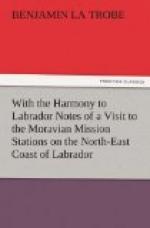______________ ______________ | | | | | 805 | | 741 | | Harriott | | Eleonora | | 1865-1882 | | 1819-1879 | |______________| |______________|
Scarcely any grass grows within the oblong space surrounded by wooden palings, but here and there patches of moss or low berry bushes threaten to hide the neat little slabs of wood placed by the missionaries on the graves of the native Christians. If left to the Eskimoes, this duty to their departed relatives and friends would either be done carelessly or forgotten. These simple “headstones,” of which I give two specimens as copied into my notebook, are perhaps about twelve inches by eight. The place for the next grave in each row (men, women, boys, girls) is indicated by long poles likely to appear above the highest snow in winter. Here at Nain, and indeed at all the stations except Okak, where the soil is clay, it is possible, though in winter very troublesome, to dig a grave all the year round. At Okak the coffin must be laid in the snow until returning spring thaws the frozen ground. As already stated, the Eskimoes have no surnames, and their graves show a great repetition of certain Christian names, as Abel, Abia, Zecharias, Thomas, Susannah, Katarina, &c. There is a greater variety on the female side. At Zoar I noted some curious ones—Persida, Botille, Teresia Dina, and Justine. “Helena-Helenalo” evidently means mother and child, both bearing the name Helena. “Fillipusib-kitornganga” and “Davidib-kitornganga” mean the child of Philip and the child of David. Mostly, the little wooden “headstones” lie flat on the grave; those at Okak are placed upright, as in the accompanying sketch, and record the names of several persons buried beneath.
/--------\ / \ | 644 | | Andrew | | 1862 | | -------- | | 959 | | Marcus | | -------- | | 642 | | Heinrich | | 1873. | +----------+ | | | |
Where the paths cross one another at right angles, in the older Labrador churchyards, there is always a specially interesting group of graves. There lie, in sure and certain hope of a joyous resurrection, the bodies of good men and women, who have taken sepulchre possession of this land for their Lord. Here, too, many sorrowing missionary parents have had to lay little ones, early taken home in this bleak climate. Ah, what stories are written on those simple gravestones, when one can read between the lines!
The “God’s Acre” at Nain is as rich in historical associations as any. Christian Larsen Drachard, one of the pioneers of this mission was buried here in 1778; and beside the stone, on which is inscribed his honoured name in full, is a rough slab from the shore, placed on his grave by his own desire. Side by side to right and left of the path separating the last resting-places of the married men from those of the single missionaries lie Christopher Brasen and Gottfried Lehmann, drowned in 1774 on their return voyage from finding a site for Okak, the second station in this land. Not many days after I stood beside their graves I sailed close by the island on which their sloop was wrecked, and on whose rocks the angry sea cast their bodies.




